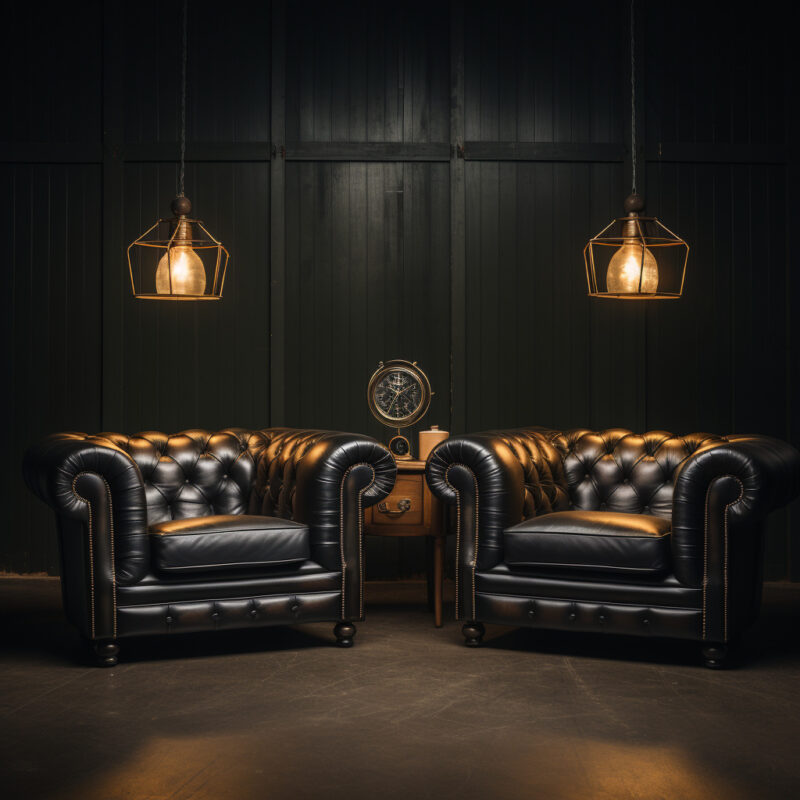A chesterfield is a sofa with a timeless appeal that has been in use for over 200 years.
This article goes into how the chesterfield sofa came to be and what makes one different from a regular sofa, etc.
History of the Chesterfield:
Chesterfields can be traced back to 17th & 18th century England. The name Chesterfield is derived from the village of Chesterfield in Derbyshire, England.
The word chesterfield was first recorded for a type of fine tobacco pipe with an amber mouthpiece, made by Francis Jessop and Paul Rodgers at their manufactory in Chesterfield around 1800. After that it referred to various kinds of deep buttoned sofas manufactured around the same period.
At first they were two separate pieces of furniture – a long sofa and an armchair which opened into a bed – but eventually they merged into the three-seater we know today by the end of 19th century . They usually have very high backs and may be upholstered in leather, velvet, tweed or corduroy.
So there’s a little background knowledge on what a chesterfield is and where it came from.

A seat for the English working classes in a pub, Chesterfield sofas have been gracing British home life for almost two centuries. This article is an attempt to document the history of Chesterfields from their origin in pubs to modern production and family rooms.
Why Chesterfield?
The Chesterfield sofa has changed very little since its original creation in the 1800’s. The Chesterfield has earned itself a reputation as the “lazy man’s” sofa because of its high arms and low seats. Traditionally made with quality materials such as horse hair and top grain leathers, Chesterfields were built to last for generations, and still do today (although sometimes with synthetic upholstery.) With almost no change to style or construction over time, Chesterfield sofas have a well-earned reputation for being a timeless classic. Chesterfield sofas descend from the “three-cushion” sofas popular in England during the late 18th century when Chesterfields were first produced, and usually take their name from the county of Chester in England where Chesterfield was founded.
What’s In a Name?
Most researchers believe Chesterfield was named after Chester County, Pennsylvania. Legend has it that during the Revolutionary War, George Washington stayed at an inn near Philadelphia with his friend James Chester. While there they discussed decorating ideas for their prospective homes, and Chester shared his wealth of knowledge on upholstery fabrics and styles with Washington who took note of this encounter as he moved forward to furnish Mount Vernon. Chester’s name was later immortalized when Washington, during his presidency, stayed at the Chesterfield Inn in New Jersey.
Fascination with Chesterfields Chesterfield sofas took America by storm in the 1920s and 30s when they became all the rage for stylish American homes. As more and more Americans became wealthy enough to own their own homes and employed skilled tradesmen to landscape them, Chesterfield sofas began appearing in inventories and advertisements for interior decorating companies throughout the country. The earliest known reference linking Chesterfield to a specific manufacturer comes from an advertisement placed by H.C. Miner Company of New York City in November 1926 that refers to “The Chesterfield Sectional Sofa” as being available from their showroom on Fifth Avenue. Chesterfields can be found today in many homes of all different styles and eras across the country, from traditional to modern. Chesterfield sofas are a truly American classic that have been continuously manufactured for almost 200 years!
Chesterfield Fads While Chesterfield sofas were traditionally made with horse hair and top grain leathers, many of them were upholstered in cheaper polyester fabrics during the 50’s and 60’s due to the trend towards more cheaply made furniture at this time. Chesterfields made during these periods can easily be identified by their lack of tufting on the seat back cushion, compared to earlier Chesterfields with an abundance of tufting in the center crest and arms. Chesterfields made during the 1950’s and 1960s also had longer skirt covers with no split backs. Chesterfields made after 1965, known as post-65 Chesterfields, were upholstered with materials such as polyester and wool blends, and included tufting on all cushions and split back cushions due to the increasing cost of leather. Chesterfield sofas today are still available in many styles and fabrics including top grain leathers, microfibers, nubuck leathers for hardy families living in coastal areas , faux leathers offered by some retailers , rayon/polyester mixes manufactured specifically for outdoor use . Chesterfields are often chosen for their exceptional value because they can last several generations when properly cared for.
Chesterfield Sofa Styles:
Chesterfield Sofa Styles Chesterfield sofas are typically available in four different styles that have remained mostly unchanged since Chesterfield’s introduction to America in the 1920’s. The first Chesterfield style is a tufted back sofa, often referred to as an English Chesterfield because tufting was originally used only on English Chesterfields. This Chesterfield style features rolled arms, deep buttoned cushions and button-tufting along the front of the sofa’s seat back cushion and armrests.
The second Chesterfield style, also known as a continental Chesterfield , can be differentiated from an English Chesterfield by its lack of buttons or tufts along the center back cushion. Instead of buttons or buttons and tufts at each end of the Chesterfield sofa’s center back cushion, this Chesterfield style is finished with piping along the front and sides.
The third Chesterfield style is called a French Chesterfield because it features rolled arms, buttoned cushions and tufting on all sides of the seat back cushion.
Unlike its English cousin, which has lumbar support in its rolled arms , the fourth Chesterfield style does not have any tufting or buttons on its arms at all. Instead, this Chesterfield club sofa includes a pocket sprung seat cushion to make up for its lack of tufting. This Chesterfield style can be identified by a flat wide bottom seam running across the length of each arm rest and a row of four large brass buttons across the top of each arm. Chesterfield Sofa Benefits Chesterfields are a great long term investment that can increase or maintain a home’s resale value depending on their quality and overall style. Chesterfields made with top grain leathers and quality fabrics, such as a blend of wool and rayon, can last up to 100 years with proper care. Chesterfield sofas also provide excellent lumbar support because they have rolled arms allowing air to flow through them on hot summer days.
Chesterfield Sofa Designs:
Chesterfields are typically available in various styles including tufted back, continental, French and club sofas , which makes it easy for any family member to find one that fits their personal style preferences. Chesterfield sofas come in many different colors, patterns and textures so Chesterfields can easily be integrated with existing furniture pieces in a room. Chesterfields are also typically available in three different sizes including standard, large and extra long versions that allow for better comfort when sitting or lounging on the Chesterfield sofa. A Chesterfield’s quality is determined by its frame, spring system , upholstery material, skirt style and loose back cushions. Chesterfields made with solid hardwood frames are of the highest quality because they offer increased sturdiness while maintaining their shape over time. Chesterfields with fully sprung seat cushion provide excellent comfort throughout the day while still taking care not to become overly soft .
Price Overview of Chesterfield:
Chesterfield sofas are usually priced according to the number of springs used in their seat cushions, skirts and arms. Chesterfield sofas are typically priced under $4000 but can reach prices of over $1,000,000 because Chesterfields are often passed down through families or simply saved for future generations to enjoy.
